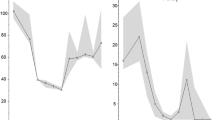Abstract
The compartmentation of CMRO2 began with Kety’s hypothesis that because anesthetics produce anesthesia through the reversible inhibition of synaptic transmission, they should affect CMRO2 only to the extent associated with synaptic transmission (Kety, 1965). Michenfelder (1975) tested this hypothesis and showed that, indeed, massive doses of thiopental infused into dogs on cardiopulmonary bypass attenuated CMRO2 only to the point of cortical electroencephalographic (EEG) silence and about 50% of normal. Continued infusion at doses several fold higher than required to abolish the cortical EEG did not further reduce CMRO2 below 50% of normal. Thus, the concept of active CMRO2 (ACMRO2), i.e., associated with an active EEG, and basal CMRO2 (BCMRO2), i.e., associated with some basal level of cerebral metabolic activity was formulated, each representing about 50% of total CMRO2 (TCMRO2). Astrup and associates (Astrup, Skovsted, et al., 1981; Astrup, Sorensen, et al., 1981) extended this concept and divided the BCMRO2 compartment into that associated with Ne+-K+ leak flux representing about 40% of BCMRO2, and the other 60% of BCMRO2 attributed to unidentified metabolic processes. Thus, thiopental allows the differentiation of the active and basal compartments by abolishing the active compartment.
Access this chapter
Tax calculation will be finalised at checkout
Purchases are for personal use only
Preview
Unable to display preview. Download preview PDF.
Similar content being viewed by others
References
Astrup, J., Skovsted P., Gjerris, F., and Sorensen H.R., 1981, Increase in extracellular potassium in the brain during circulatory arrest: Effects of hypothermia, lidocaine and thiopental, Anesthesiology 55:256–62.
Astrup, J., Sorensen, P.M., and Sorensen H.R., 1981, Inhibition of cerebral oxygen and glucose consumption in the dog by hypothermia, pentobarbital, and lidocaine, Anesthesiology 55:263–68.
Bleyaert, A.L., Nemoto, E.M., Safar, P., Stezoski, S.W., Mickell, J.J., Moossy, J., and Rao, G., 1978, Thiopental amelioration of ischemic brain damage in monkeys, Anesthesiology 49:390–98.
Kety, S.S., 1965, Discussion, Pharmacol. Rev. 230–32.
Michenfelder, J.D., 1975, The in vivo effects of massive concentrations of anesthetics on canine cerebral metabolism, in: “Molecular Mechanisms of Anesthesia, Progress in Anesthesiology,” Vol. 1, B.R. Fink, ed., pp 537–43, Raven Press, New York.
Michenfelder, J.D., 1983, The interdependency of cerebral functional and metabolic effects following massive doses of thiopental in the dog, Anesthesiology 41:231–36.
Michenfelder, J.D., and J.H. Milde, 1992, The relationship among canine brain temperature, metabolism and function during hypothermia, Anesthesiology 75:130–36.
Milde, L.N., Milde, J.H., Lanier, W.L., and Michenfelder, J.D., 1988, Comparison of the effects of isoflurane and thiopental on neurologic outcome and neuropathology after temporary focal cerebral ischemia in primates, Anesthesiology 69:905–13.
Minamisawa, H., Nordstrom, C.H., Smith, M.L., and Siesjo, B.K., 1990, The influence of mild body and brain hypothermia on ischemic brain damage, J. Cereb. Blood Flow Metab. 10:365–74.
Moseley, J.I., Laurent, J.P., and Molinari, G.F., 1975, Barbiturate attenuation of the clinical course and pathologic lesions in a primate stroke model, Neurology 25:879.
Newberg, L.A., Milde, J.H., and Michenfelder, J.D., 1983, The cerebral metabolic effects of isoflurane at and above concentrations that suppress cortical electrical activity, Anesthesiology 59:23–28.
Singh, N.D., Kochanek, P.M., Schiding, J.K., Melick, J.A., and Nemoto, E.M., 1992, Uncoupled cerebral blood flow and metabolism after severe global ischemia in rats, J. Cereb. Blood Flow Metab. 12:802–08.
Smith, A.L, Hoff, J.T., Nielsen, S.L., and Larson, C.P., 1974, Barbiturate protection in acute focal cerebral ischemia, Stroke 1:1–7.
Steen, P.A., Newberg, L., Milde, J.H., and Michenfelder, J.D., 1983, Hypothermia and barbiturates: Individual and combined effects of canine cerebral oxygen consumption, Anesthesiology 58:527–532.
Author information
Authors and Affiliations
Editor information
Editors and Affiliations
Rights and permissions
Copyright information
© 1994 Springer Science+Business Media New York
About this chapter
Cite this chapter
Nemoto, E.M., Klementavicius, R., Melick, J.A., Yonas, H. (1994). Effect of Mild Hypothermia on Active and Basal Cerebral Oxygen Metabolism and Blood Flow. In: Hogan, M.C., Mathieu-Costello, O., Poole, D.C., Wagner, P.D. (eds) Oxygen Transport to Tissue XVI. Advances in Experimental Medicine and Biology, vol 361. Springer, Boston, MA. https://doi.org/10.1007/978-1-4615-1875-4_84
Download citation
DOI: https://doi.org/10.1007/978-1-4615-1875-4_84
Publisher Name: Springer, Boston, MA
Print ISBN: 978-1-4613-5763-6
Online ISBN: 978-1-4615-1875-4
eBook Packages: Springer Book Archive




